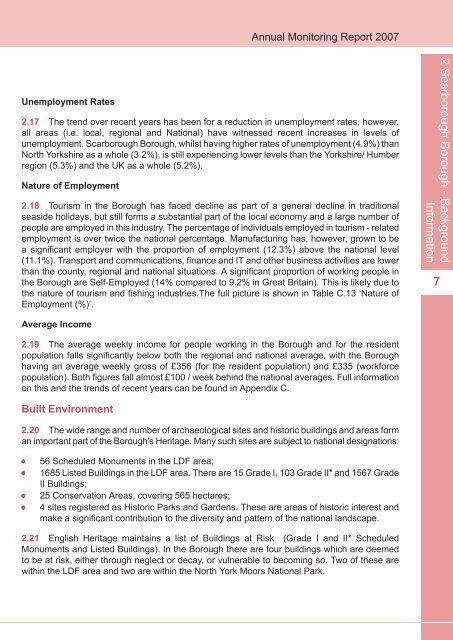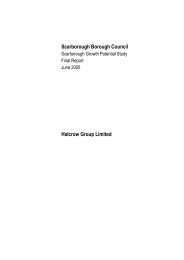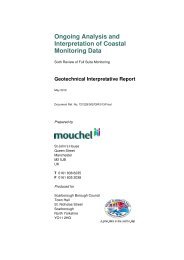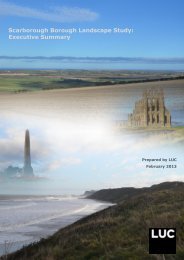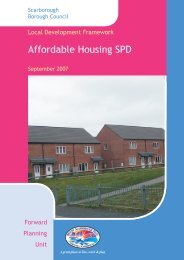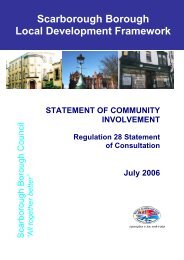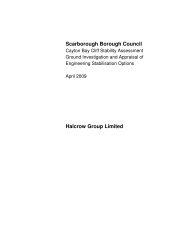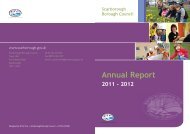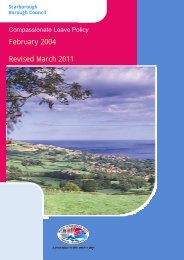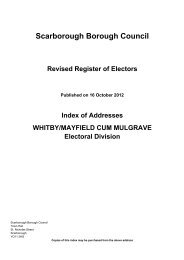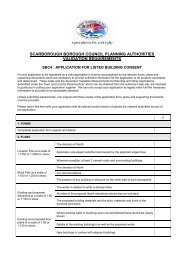Annual Monitoring Report 2007(6.6MB) - Scarborough Borough ...
Annual Monitoring Report 2007(6.6MB) - Scarborough Borough ...
Annual Monitoring Report 2007(6.6MB) - Scarborough Borough ...
You also want an ePaper? Increase the reach of your titles
YUMPU automatically turns print PDFs into web optimized ePapers that Google loves.
<strong>Annual</strong> <strong>Monitoring</strong> <strong>Report</strong> <strong>2007</strong><br />
Unemployment Rates<br />
2.17 The trend over recent years has been for a reduction in unemployment rates, however,<br />
all areas (i.e. local, regional and National) have witnessed recent increases in levels of<br />
unemployment. <strong>Scarborough</strong> <strong>Borough</strong>, whilst having higher rates of unemployment (4.9%) than<br />
North Yorkshire as a whole (3.2%), is still experiencing lower levels than the Yorkshire/ Humber<br />
region (5.3%) and the UK as a whole (5.2%).<br />
Nature of Employment<br />
2.18 Tourism in the <strong>Borough</strong> has faced decline as part of a general decline in traditional<br />
seaside holidays, but still forms a substantial part of the local economy and a large number of<br />
people are employed in this industry. The percentage of individuals employed in tourism - related<br />
employment is over twice the national percentage. Manufacturing has, however, grown to be<br />
a significant employer with the proportion of employment (12.3%) above the national level<br />
(11.1%). Transport and communications, finance and IT and other business activities are lower<br />
than the county, regional and national situations. A significant proportion of working people in<br />
the <strong>Borough</strong> are Self-Employed (14% compared to 9.2% in Great Britain). This is likely due to<br />
the nature of tourism and fishing industries.The full picture is shown in Table C.13 ‘Nature of<br />
Employment (%)’.<br />
2 <strong>Scarborough</strong> <strong>Borough</strong> - Background<br />
Information<br />
7<br />
Average Income<br />
2.19 The average weekly income for people working in the <strong>Borough</strong> and for the resident<br />
population falls significantly below both the regional and national average, with the <strong>Borough</strong><br />
having an average weekly gross of £356 (for the resident population) and £335 (workforce<br />
population). Both figures fall almost £100 / week behind the national averages. Full information<br />
on this and the trends of recent years can be found in Appendix C.<br />
Built Environment<br />
2.20 The wide range and number of archaeological sites and historic buildings and areas form<br />
an important part of the <strong>Borough</strong>'s Heritage. Many such sites are subject to national designations:<br />
56 Scheduled Monuments in the LDF area;<br />
1685 Listed Buildings in the LDF area. There are 15 Grade I, 103 Grade II* and 1567 Grade<br />
II Buildings;<br />
25 Conservation Areas, covering 565 hectares;<br />
4 sites registered as Historic Parks and Gardens. These are areas of historic interest and<br />
make a significant contribution to the diversity and pattern of the national landscape.<br />
2.21 English Heritage maintains a list of Buildings at Risk (Grade I and II* Scheduled<br />
Monuments and Listed Buildings). In the <strong>Borough</strong> there are four buildings which are deemed<br />
to be at risk, either through neglect or decay, or vulnerable to becoming so. Two of these are<br />
within the LDF area and two are within the North York Moors National Park.


